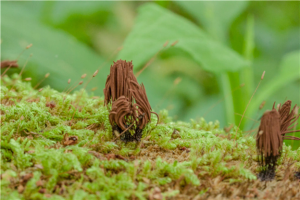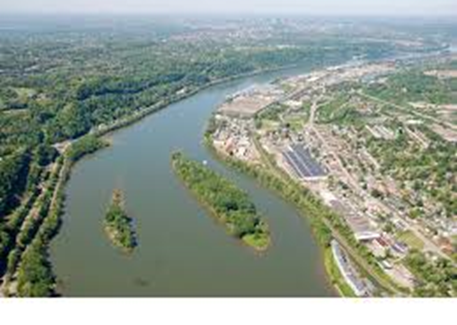Sycamore Island
By La Monte H.P. Yarroll
Western Pennsylvania Mushroom Club

Since 2014, the Western Pennsylvania Mushroom Club (WPMC) has been running a regular survey of Sycamore Island mushroom and slime mold species for the Allegheny Land Trust. Turnout runs from 20 to 40 citizen scientists, including both seasoned mushroom hunters and beginners.
Allegheny CleanWays provides use of its pontoon boat to shuttle participants from the Steel City Rowing Club dock on Arch Street in Verona to the island. The survey has contended with rain a couple of times, but this hardly dampens participation.
The survey spends a couple hours on the island collecting samples and then returns to Verona for an hour or so of identification work. Beginners and other participants ask questions of the club Mycologists and Identifiers throughout the time on the island. The questions continue during the identification process.
The island hosts a unique floodplain hardwood forest which provides habitat for a distinctive flora, including several species the WPMC has found nowhere else, such as Calvatia rugosa, a golden yellow puffball. So far, the survey has identified about 75 species on the island, but we still add new species on every walk due to small variations in season and fruiting conditions. The real species count is likely much higher.
A few of the species on the island are edible, which never fails to excite visitors, especially those new to hunting mushrooms. So far, the survey has not identified any of the deadly poisonous species from the area on the island, but we fully expect to eventually find at least one of them. Most of the fungi we find are simply of no culinary interest. Some fungi (saprobes) help clear the forest of deadwood. Some are parasites on trees. Many grow in the roots of trees in a mutually beneficial relationship called mycorrhyzal.
WPMC runs the survey twice a year, once in the spring and once in the fall. Fungi are very seasonal and this schedule covers the major flushes.
WPMC has collected permanent herbarium specimens of a few species from the island as part of the North American Mycoflora Project. The Mycoflora Project aims to collect complete information about all macro fungi (those large enough to be seen with the naked eye). Complete information includes photos, herbarium samples, descriptions, identification protocols, and DNA fingerprints. A DNA fingerprint is a short section of the complete DNA of an organism, which can be used to determine the genus and species. DNA fingerprints are the current gold standard for species identification.
WPMC has been one of the leading proponents of amateur DNA collection of fungi. WPMC has an arrangement with Duke University to get our DNA collections sequenced and archived. The DNA collections are made on special filter paper (FTA cards) that stabilizes the DNA. FTA cards are better at safely storing DNA than even carefully prepared dried collections. While the cost of DNA sequencing has dropped significantly over the last few years, sequencing the full genome of a mushroom is still cost-prohibitive. WPMC collects enough DNA to get fingerprints now and still have plenty left over for full sequencing once the cost has dropped enough.
The ongoing relationship between Allegheny Land Trust and the Western Pennsylvania Mushroom Club has proven fruitful to both organizations. In 2017, WPMC will be starting surveys at several other ALT properties and participating in several ALT BioBlitzes.

